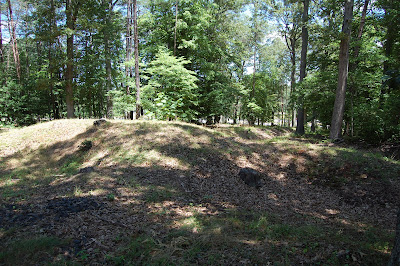In the late summer of 1864, as Union General Sherman was pressing his forces around Atlanta, there was cause for concern that the POW stockade at Andersonville, Georgia could be overrun, allowing the liberation of the Union men held there. In an effort to prevent this, a stockade was prepared in Florence, South Carolina, approximately 90 miles north of Charleston, and it was to there that the able bodied prisoners of Andersonville were to be transferred by train. The first prisoners would arrive in September. In the five months this stockade was in operation, as many as 18,000 Union soldiers were held there. With an initial death rate of 20 to 30 men a day, a total of about 2,800 would perish. Among them were as many as 14 of the Pennsylvania and New Jersey soldiers captured on May 14, 1864 during the fighting on Myer's Hill, near Spotsylvania Courthouse. Accurate death and burial records failed to survive the war, and these men may likely be interred in the 16 burial trenches containing 2,167 "unknowns", at what is now the Florence National Cemetery.
We visited Florence on Monday, October 18, on our journey back to Spotsylvania from a family gathering in Charleston. My special thanks to NPS historian Eric Mink for his last minute trip advice as we traveled up Interstate 95.
Entrance to the Florence National Cemetery
One of the 32 upright marble headstones that mark sections of the 16 burial trenches.
On the south side of the cemetery, at the end of Stockade Road, is the site of the former prison camp, maintained and interpreted by the Friends of the Florence Stockade, who have a Facebook page currently here. The above photograph shows an informational Gazebo with numerous illustrated panels detailing the history of the site. It is stop # 1 on a 16 stop walking trail.
Map detailing the stockade and surrounding defensive works.
The stockade itself was 23.5 acres, 3 acres smaller than Andersonville.
This view is taken from near the south west corner of the stockade.
The path runs parallel to what was the south wall of the stockade.
This illustration looks from the south wall along the sole water source for the prison, the Pye Branch of Stockade Creek. The drawings were created by James E, Taylor for Ezra Hoyt Ripple's published account of his experiences as a prisoner of war. Drinking water was taken from the northern (far) third of the creek, the middle was used for bathing, and the final third was utilized for the latrine, a wooden, open air facility seen at lower right, running along the creek length. Conditions are said to have been at least equal to and in some estimations, worse than those suffered at Andersonville.
An incident at the Stockade, also illustrated by Taylor. Note the similarity to Andersonville's construction and prisoner living conditions.




















































